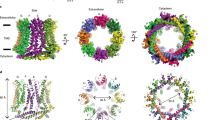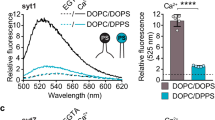Abstract
1. The lipid bilayer technique was used to characterize the biophysical and pharmacological properties of several ion channels formed by incorporating amyloid beta protein fragment (AβP) 1–40 into lipid membranes. Based on the conductance, kinetics, selectivity, and pharmacological properties, the following AβP[1–40]-formed ion channels have been identified:
(i) The AβP[1–40]-formed “bursting” fast cation channel was characterized by (a) a single channel conductance of 63 pS (250/50 mM KCl cis/trans) at +140 mV, 17 pS (250/50 mM KCl cis/trans) at −160 mV, and the nonlinear current–voltage relationship drawn to a third-order polynomial, (b) selectivity sequence P K > P Na > P Li = 1.0:0.60:0.47, (c) Po of 0.22 at 0 mV and 0.55 at +120 mV, and (d) Zn2+-induced reduction in current amplitude, a typical property of a slow block mechanism.
(ii) The AβP[1–40]-formed “spiky” fast cation channel was characterized by (a) a similar kinetics to the “bursting” fast channel with exception for the absence of the long intraburst closures, (b) single channel conductance of 63 pS (250/50 KCl) at +140 mV 17 pS (250/50 KCl) at −160 mV, the current–voltage relationship nonlinear drawn to a third-order polynomial fit, and (c) selectivity sequence P Rb > P K > P Cs > P Na > P Li = 1.3:1.0:0.46:0.40:0.27.
(iii) The AβP[1–40]-formed medium conductance channel was charcterized by (a) 275 pS (250/50 mM KCl cis/trans) at +140 mV and 19 pS (250/50 mM KCl cis/trans) at −160 mV and (b) inactivation at Vms more negative than −120 and more positive than +120 mV.
(iv) The AβP[1–40]-formed inactivating large conductance channel was characterized by (a) fast and slow modes of opening to seven multilevel conductances ranging between 0–589 pS (in 250/50 mM KCl) at +140 mV and 0–704 pS (in 250/50 mM KCl) at −160 mV, (b) The fast mode which had a conductance of <250 pS was voltage dependent. The inactivation was described by a bell-shaped curve with a peak lag time of 7.2 s at +36 mV. The slow mode which had a conductance of >250 pS was also voltage dependent. The inactivation was described by a bell-shaped curve with a peak lag time of 7.0 s at −76 mV, (c) the value of P K/P choline for the fast mode was 3.9 and selectivity sequence P K > P Cs > P Na > P Li = 1.0:0.94:0.87:0.59. The value of P K/P choline for the slow mode was 2.7 and selectivity sequence P K > P Na > P Li > P Cs = 1.0:0.59:0.49:0.21, and (d) asymmetric blockade with 10 mM Zn2+-induced reduction in the large conductance state of the slow mode mediated via slow block mechanism. The fast mode of the large conductance channel was not affected by 10 mM Zn2+.
2. It has been suggested that, although the “bursting” fast channel, the “spiky” fast channel and the inactivating medium conductance channel are distinct, it is possible that they are intermediate configurations of yet another configuration underlying the inactivating large conductance channel. It is proposed that this heterogeneity is one of the most common features of these positively-charged cytotoxic amyloid-formed channels reflecting these channels ability to modify multiple cellular functions.
3. Furthermore, the formation of β-sheet based oligomers could be an important common step in the formation of cytotoxic amyloid channels.
Similar content being viewed by others
REFERENCES
Arispe, N., Pollard, H. B., and Rojas, E. (1993a). Giant multilevel cation channels formed by Alzheimer disease amyloid beta-protein [AβP-(1–40)] in bilayer membranes. Proc. Natl. Acad. Sci. USA 90:10573-10577.
Arispe, N., Rojas, E., and Pollard, H. B. (1993b). Alzheimer disease amyloid β protein forms calcium channels in bilayer membranes: Blockade by tromethamine and aluminum. Proc. Natl. Acad. Sci. USA 90:567-571.
Arispe, N., Pollard, H. B., and Rojas, E. (1994). β-amyloid Ca2+-channel hypothesis for neuronal death in Alzheimer disease. Mol. Cell. Biochem. 140:119-125.
Arispe, N., Pollard, H. B., and Rojas, E. (1996). Zn2+ interaction with Alzheimer amyloid β protein calcium channels. Proc. Natl. Acad. Sci. USA 93:1710-1715.
Barry, P. H. (1994). JPCalc, a software package for calculating liquid junction potential corrections in patch-clamp, intracellular, epithelial and bilayer measurements and for correcting junction potential measurements. J. Neurosci. Meth. 51:107-116.
Bush, A. I., Pettingell, W. H., Jr., Paradis, M. D., and Tanzi, R. E. (1994). Modulation of A beta adhesiveness and secretase site cleavage by zinc. J. Biol. Chem. 269:12152-1258.
Catterall, W. A. (1992). Cellular and molecular biology of voltage-gated sodium channels. Physiol. Rev. 72:S15-48.
Colquhoun, D., and Hawkes, A. G. (1983). Fitting and statistical analysis of single-channel recording. In Sakmann, B., and Neher, E. (ed.), Single Channel Recording, Plenum, New York, pp. 135-175.
Durell, S. R., Guy, H. R., Arispe, N., Rojas, E., and Pollard, H. B. (1994). Theoretical models of the ion channel structure of amyloid beta-protein. Biophys. J. 67:137-145.
Fraser, S. P., Suh, Y. H., Chong, Y. H., and Djamgoz, M. B. (1996). Membrane currents induced in Xenopus oocytes by the C-terminal fragment of the beta-amyloid precursor protein. J. Neurochem. 66:2034-2040.
Hirakura, Y., and Kagan, B. L. (1999). Channel formation in the pathogenesis of Alzheimer's disease and other amyloidoses. Einstein Quart. J. Biol. Med. 16:124-129.
Hirakura, Y., Lin, M.-C., and Kagan, B. L. (1999). Alzheimer amyloid Aβ1–42 channels: effects of solvent, pH, and Congo Red. J. Neurosci. Res. 57:458-466.
Hirakura, Y., Satoh, Y., Hirashima, N., Suzuki, T., Kagan, B. L., and Kirino, Y. (1998). Membrane perturbation by the neurotoxic Alzheimer amyloid fragment β25–35 requires aggregation and β-sheet formation. Biochem. Mol. Biol. Int. 46:787-794.
Hirakura, Y., Yiu, W. W., Yamamoto, A., and Kagan, B. L. (2000). Amyloid peptide channels: Blockade by zinc and inhibition by congo red. Amyloid 7:194-199.
Hodgkin, A. L., and Katz, B. (1949). The effect of sodium ions on the electrical activity of the giant axon of the squid. J. Physiol. Lond. 108:37-77.
Jalonen, T. O., Charniga, C. J., and Wielt, D. B. (1997). beta-Amyloid peptide-induced morphological changes coincide with increased K+ and Cl− channel activity in rat cortical astrocytes. Brain. Res. 746:85-97.
Kawahara, M., Arispe, N., Kuroda, Y., and Rojas, E. (1997). Alzheimer's disease amyloid β-protein forms Zn2+-sensitive, cation-selective channels across excised membrane patches from hypothalamic neurons. Biophys. J. 73:67-75.
Kim, H. J., Suh, Y. H., Lee, M. H., and Ryu, P. D. (1999). Cation selective channels formed by a C-terminal fragment of beta-amyloid precursor protein. Neuroreport 10:1427-1431.
Kourie, J. I. (1996). Vagaries of artificial bilayers and gating modes of the SCl channel from the sarcoplasmic reticulum of skeletal muscle. J. Membr. Sci. 116:221-227.
Kourie, J. I. (1999a). Synthetic C-type Natriuretic Peptide forms large cation selective channels. FEBS. Lett. 445:57-62.
Kourie, J. I. (1999b). Characterisation of a C-type natriuretic peptide CNP-39-formed cation-selective channel from platypus Ornithrorhynchus anatinus venom. J. Physiol. Lond. 518:359-369.
Kourie, J. I. (In press-a). Mechanisms of amyloid-induced modification in the electrical properties of membranes. Cell. Mol. Neurobiol. 21.
Kourie, J. I. (In press-b.). Mechanisms of prion-induced modification in membrane transport systems. Chem. Biol. Interactions.
Kourie, J. I., and Culverson, A. (2000). Prion fragment PrP[106–126] forms distinct channel types. J. Neurosci. Res. 62:120-133.
Kourie, J. I., Laver, D. R., Junankar, P. R., Gage, P. W., and Dulhunty, A. F. (1996). Characteristic of two types of chloride channel in sarcoplasmic reticulum vesicles from rabbit skeletal muscle. Biophys. J. 70:202-221.
Kourie, J. I., and Shorthouse, A. A. (2000). Properties of cytotoxic peptide-formed ion channels. Am. J. Physiol. 278:C1063-C1087.
Lin, M.-C., Mirzabekov, T., and Kagan, B. L. (1997). Channel formation by a neurotoxic prion protein fragment. J. Biol. Chem. 272:44-47.
Liu, S.-T., Howlett, G., and Barrow, C. J. (1999). Histidine-13 is a crucial residue in the zinc ion-induced aggregation of Aβ peptide of Alzheimer's disease. Biochem. 38:9373-9378.
Miller, C., Racker, E. (1976). Ca++-induced fusion of fragmented sarcoplasmic reticulum with artificial planar bilayers. J. Membr. Biol. 30:283-300.
Mirzabekov, T. A., Lin, M.-C., and Kagan, B. L. (1996). Pore formation by the cytotoxic islet amyloid peptide amylin. J. Biol. Chem. 271:1988-1992.
Mirzabekov, T., Lin, M., Yuan, W., Marshall, P. J., Carman, M., Tomaselli, K., Lieberburg, I., and Kagan, B. (1994). Channel formation in planar lipid bilayers by a neurotoxic fragment of the beta-amyloid peptide. Biochem. Biophys. Res. Commun. 202:1142-1148.
Patlak, J. B. (1993). Measuring kinetics of complex single ion channel data using mean-variance histograms. Biophys. J. 65:29-42.
Pollard, H. B., Arispe, N., and Rojas, E. (1995). Ion channel hypothesis for Alzheimer amyloid peptide neurotoxicity. Cell. Mol. Neurobiol. 15:513-526.
Simmons, M. A., and Schneider, C. R. (1993). Amyloid β peptides act directly on single neurons. Neurosci. Lett. 150:133-136.
Author information
Authors and Affiliations
Rights and permissions
About this article
Cite this article
Kourie, J.I., Henry, C.L. & Farrelly, P. Diversity of Amyloid β Protein Fragment [1–40]-Formed Channels. Cell Mol Neurobiol 21, 255–284 (2001). https://doi.org/10.1023/A:1010995121153
Issue Date:
DOI: https://doi.org/10.1023/A:1010995121153




